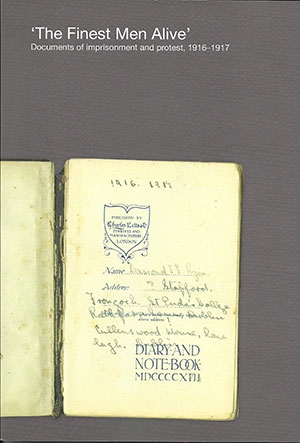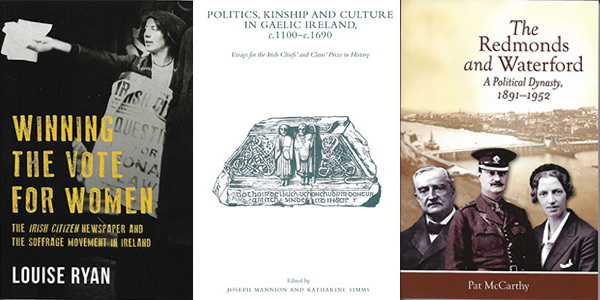BOOKWORM
Published in Book Reviews, Issue 4 (July/August 2018), Reviews, Volume 26By Joe Culley
(Twitter: @TheRealCulls)
In the 1930s Ernie O’Malley began conducting interviews with some of his former comrades from his revolutionary days. Initially the interviews were informal and were designed to help him prepare his memoirs. In the late 1940s and early 1950s, however, O’Malley intensified his research, travelling the country as a sort of rogue one-man sub-office of the Bureau of Military History (BMH) and often focusing on veteran anti-Treatyites for a planned study of the Civil War. Indeed, many of his witnesses had refused to cooperate with the BMH or to apply for pensions. He conducted well over 600 interviews.
Some excerpts of his notebooks relating to Mayo and to Galway have already been published. Now The men will talk to me: Ernie O’Malley’s interviews with the northern divisions turns to events in Ulster. There are some big names here among the fourteen interviewees: Peadar O’Donnell, Joe Sweeney, Frank Aiken, Pat McCartan and Charlie Daly.
Two themes that the editors of this volume emphasise are, first, the sheer sectarianism of much of the violence in Ulster—a truth often neglected if not actively ignored in the south—and, second, how northern republicans were immediately shut out by the Treaty. In fact, the worst of the violence in Ulster was over before the outbreak of the Civil War.
Much of it is fascinating, but it remains hard work for the uninitiated or general reader. The editors do a heroic job of providing the needed annotations and footnotes on the players and their activities. Nevertheless, O’Malley’s text can be, well, cryptic. Among other issues, it is often difficult to tell whether the words are those of the witness or interjections from O’Malley. Nevertheless, it will be essential reading for students of the period.


Now, here’s a curious one, in the sense that it is not a ‘book’ as such. It is, instead, the catalogue for the on-line exhibition ‘The finest men alive’: documents of imprisonment and protest, 1916–1917, which is part of the Google Arts & Culture initiative. Brian Hanley has sifted through the vast collection of papers at UCD and chosen extracts from prison notebooks, secret communications, diaries and family correspondence, which give a sense of how the republican movement mutated between the end of the Rising and the general amnesty in June 1917. Among the prisoners telling their tales are, of course, the usual heads—Dev, MacNeill, FitzGerald—but we also hear from slightly less prominent figures such as Sighle Humphreys, Bernard O’Rourke, Mary MacSwiney and Thomas McPartlin.
As well as being extremely interesting, the catalogue is also gorgeous. The reproductions jump off the page—almost literally; I honestly tried to peel the first image away. The catalogue is available—free—by post from UCD Archives. The exhibition, which includes video, can be found at https://artsandculture.google.com/exhibit/NALyDC4HOTpbIw.
While the result of the recent referendum suggests that Irish society has finally decided that its women can be trusted, Louise Ryan’s timely Winning the vote for women: the Irish Citizen newspaper and the suffrage movement in Ireland is a reminder of how long and difficult the struggle has been (and continues to be). Much of the book is given over to extracts from the paper, which emphasise that the suffrage movement was interested in much more than the franchise. Other issues addressed include workers’ rights, the class struggle, the war, and morality and the law.
The second collection of essays to emerge from the continuing prize competition organised by the Irish Chiefs and Chieftains and the Clans of Ireland is Politics, kinship and culture in Gaelic Ireland, c. 1100–c. 1690. Among several engaging contributions are Stephen Kestell on the demise of Feagh McHugh O’Byrne, Lora O’Brien’s most entertaining survey of the legend of Queen Medb in Gaelic literature, and Con Connor on recreating the Lucas type 1 formal footwear of a chieftain.
While we are familiar with John Redmond and his brother Willie, Waterford historian Pat McCarthy continues the family story in The Redmonds and Waterford: a political dynasty, 1891–1952. After the great man’s death, his son, William Archer, took his Westminster seat and was then elected to the Dáil. On his premature death, his widow, Bridget, took and held the seat.

The most recent effort from the prolific John Wyse Jackson is the handsome and entertaining Best-loved Swift. The author has selected a representative sample of Swift’s fiction, personal letters, poems and social satires, each accompanied by an informative introduction. One design quibble for the publisher: the (few) bits with white type on red paper are too difficult to read.
A similar production from O’Brien is Nicola Pierce’s Titanic: true stories of her passengers, crew and legacy, another handsome hardback. Pierce covers every conceivable angle, including the animals on board: publisher Henry Harper had brought his Pekingese, Sun Yat-sen.
To mark the 25th anniversary of the Dublinia exhibition at Christ Church, the busy O’Brien Press has issued Dublin and the Viking world, a beautifully illustrated journey into the day-to-day life of Ireland’s first fully functioning town. Themes touched upon include shipbuilding, the slave trade, food and drink, religion and hygiene.
Prominent human rights and gay rights activist Jeffrey Dudgeon has produced a slim biography of a man from whom he clearly drew huge inspiration, H. Montgomery Hyde: Ulster Unionist MP, gay law reform campaigner and prodigious author. The title says it all.
Finally, the local historical society has published Newcastle West in close-up: snapshots of an Irish provincial town. It’s an extremely well-designed coffee-table hardback collection of images.

Síobhra Aiken, Fearghal Mac Bhloscaidh, Liam Ó Duibhir and Diarmuid Ó Tuama (eds), The men will talk to me: Ernie O’Malley’s interviews with the northern divisions (Merrion Press, €19.99 pb, 300pp, ISBN 9781785371646).
Kate Manning and Brian Hanley (eds), ‘The finest men alive’: documents of imprisonment and protest, 1916–1917 (UCD Archives, free pb, 72pp, available from UCD Archives, James Joyce Library, Belfield, Dublin 4).
Louise Ryan, Winning the vote for women: the Irish Citizen newspaper and the suffrage movement in Ireland (Four Courts Press, €19.95 pb, 240pp, ISBN 9781846827013).
Joseph Mannion and Katharine Simms (eds), Politics, kinship and culture in Gaelic Ireland, c. 1100–c.1690: essays for the Irish Chiefs’ and Clans’ Prize in History (Wordwell, €25 pb, 160pp, ISBN 9781999790929).
Pat McCarthy, The Redmonds and Waterford: a political dynasty, 1891–1952 (Four Courts Press, €24.95 pb, 224pp, ISBN 9781846827037).
John Wyse Jackson, Best-loved Swift (O’Brien Press, €12.99 hb, 128pp, ISBN 978184717948).
Nicola Pierce, Titanic: true stories of her passengers, crew and legacy (O’Brien Press, €10.99 hb, 240pp, ISBN 9781847179470).
Howard B. Clarke, Sheila Dooley and Ruth Johnson (eds), Dublin and the Viking world (O’Brien Press, €11.99 pb, 144pp, ISBN 9781788490160).
Jeffrey Dudgeon, H. Montgomery Hyde: Ulster Unionist MP, gay law reform campaigner and prodigious author (Belfast Press, £9 pb, 48pp, ISBN 9780953928798).
Newcastle West Historical Society, Newcastle West in close-up: snapshots of an Irish provincial town (Newcastle West Historical Society, $30 hb, 199pp, ISBN 9780992698867).
















